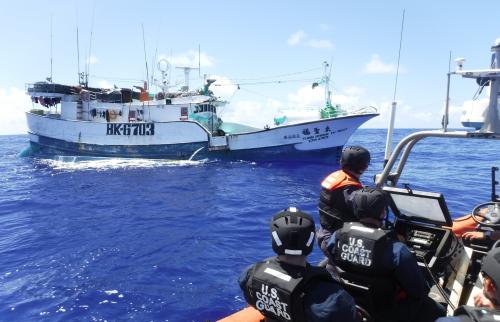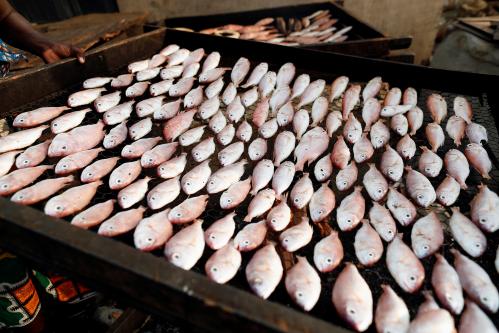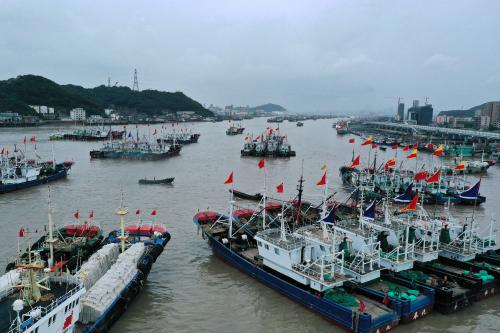This piece is part of a series titled “Nonstate armed actors and illicit economies in 2024” from Brookings’s Initiative on Nonstate Armed Actors.
Over the past few years, illegal, unreported, and unregulated (IUU) fishing has moved from obscurity to recognition as a global threat, a U.S. national security concern, and the topic of a New York Times best seller. Multiple international bodies have developed agreements to combat it. The president of the United States directed executive agencies to address it. Given all this awareness and activity, it would be reasonable to think that global efforts are having an impact in countering IUU fishing.
Measurable improvement on a global scale, however, remains elusive. The IUU Fishing Risk Index benchmarks countries based on their vulnerability to, the prevalence of, and their response to IUU fishing. The 2023 biannual index report showed a slightly worse overall score compared to 2021 but broadly presented no notable global shift or improvement.
At some point, U.S. and global efforts must turn the tide on illegal fishing. Could 2024 be that turning point?
U.S. efforts in 2023
A year ago, my colleague Brad McNally wrote that in 2023, U.S. policies must be “translated into increased and tangible action.” In many ways, they were. In June, the Biden administration provided an update on steps taken to address IUU fishing. In addition to establishing numerous working groups, awareness campaigns, and high-level engagements, several actions are worth noting.
First, the U.S. Treasury Department’s Office of Foreign Assets Control (OFAC) leveraged the Global Magnitsky Human Rights Accountability Act at the intersection of IUU fishing and human rights abuses. They sanctioned two individuals (one Chinese national and another from Hong Kong) and the entities they control, including a NASDAQ-traded company (a first-ever for OFAC), and 157 Chinese-flagged fishing vessels.
Second, the United States continued to make progress in maritime domain awareness. Web-based SeaVision, developed by the Department of Transportation and the U.S. Navy to share a range of maritime information to improve operations and security, was expanded with functional updates and radio frequency data. It was used operationally in multiple IUU fishing enforcement cases. In addition, the Coast Guard signed a memorandum of understanding with Global Fishing Watch, an international nonprofit organization focused on advancing ocean governance through transparency.
Finally, the United States leaned into international partnerships. The National Oceanic and Atmospheric Administration, working with other agencies, led efforts to build capacity to detect, deter, and interdict IUU fishing in Colombia, Ecuador, Peru, Vietnam, Thailand, the Philippines, and Indonesia. The Coast Guard established an IUU Fishing Center of Expertise in Hawaii, moved a cutter to the Pacific, and developed new partnerships.
Leveraging a nexus of illicit activity
Sanctions imposed under Executive Order 13818 and the Global Magnitsky Act represent a relatively new tool that the United States can leverage against IUU fishing. Given the links between IUU fishing and forced labor and human trafficking, especially in distant-water fishing fleets, sanctioning fisheries entities for their human rights abuses could be effective in countering other illegal practices — especially IUU fishing.
There may be an opportunity to work with nonprofit organizations and investigative journalists who are already highlighting human rights abuses at sea to build sanctions justifications. For example, the nonprofit Outlaw Ocean Project partnered with the Los Angeles Times to report on human rights abuses aboard Chinese distant-water squid fishing fleets, including a recent cover story on deaths aboard such vessels. While the ships in these articles are not necessarily fishing illegally, according to a recent report, 45 of them disabled their public tracking systems for a total of 23,000 hours, a practice associated with IUU fishing.
Identifying human rights abuses and imposing sanctions are only part of the effort; making them effective is a further challenge. Many foreign entities have limited exposure to U.S. sanctions. For example, while the United States imported $1.7 billion in seafood from China in 2021, this represented less than 13% of China’s seafood exports, and, by weight, China only exported about 5% of the seafood it produced that year. In other words, losing access to the U.S. market is likely not a significant deterrence for illicit activity, especially considering that the two main companies OFAC sanctioned received millions of dollars in Chinese government subsidies.
The United States should continue to identify foreign entities operating at the nexus of IUU fishing and human rights abuses and leverage the Global Magnitsky Act to impose sanctions on them. It should also, however, coordinate internationally to amplify the effect of those sanctions — encouraging partners to impose similar measures and working with the flag states of vessels identified.
In addition, the United States should explore other nexuses of illicit activity and IUU fishing. Efforts against Mexican cartels’ fentanyl trafficking should also address their diversified activities, including illegal fishing. Counternarcotics task forces could bring additional expertise and resources to countering IUU fishing, especially in areas where drug trafficking and illegal fishing overlap geographically or within the same organizations. Also important to explore are links between IUU fishing and national security, especially in light of reports that China’s distant-water fishing fleet also serves its nation’s foreign policy objectives.
China’s importance
United Nations Food and Agriculture Organization (FAO) data illustrates the staggeringly large role China plays in the global seafood industry. China is the world’s largest producer of aquatic animal products, generating 35% of the world’s seafood in 2020. This includes 15% of global capture (non-aquaculture) fisheries, more than the second and third-ranked countries combined. China is also the world’s largest consumer of aquatic foods, alone consuming 36% of the world’s total in 2019. It is the top seafood importer and exporter by volume. China also has the world’s largest fishing fleet, with an estimated 564,000 vessels, and the world’s largest distant-water fishing fleet with nearly 3,000 vessels — more than ten times that of the United States or the European Union — and potentially many more.
Therefore, Chinese participation is critical to the global effort to counter IUU fishing, and 2023 saw China take several actions. In June, China accepted the World Trade Organization’s Agreement on Fisheries Subsidies, which protects against harmful subsidies, including for vessels engaged in IUU fishing. China’s acceptance coincided with changing its subsidies from fuel-centric to focused on fisheries stewardship. In addition, China’s 14th Five-Year Plan for Fishery Development promotes aquaculture while limiting catch and shrinking fleets, which, if successful, may also reduce IUU fishing. The Chinese government also claims to have levied over $137 million in fines for illegal fishing. Taken in context with statements from President Xi Jinping, these actions align with broader Chinese environmental and economic efforts, and likely represent China seeking a greater leadership role in global maritime policy — from which it could shape rules in its interest. That said, it remains to be seen if these changes are merely symbolic or reflect a genuine effort to counter IUU fishing.
Moving forward, China should follow through on its rhetoric regarding sustainability and regulate its fisheries while supporting international efforts to counter IUU fishing. It should join the FAO’s Port State Measures Agreement, which seeks to prevent IUU fishing vessels from landing their catches. Building on a 2023 agreement with South Korea, China should also require its fishing vessels to consistently transmit their positions via the internationally recognized automatic identification system (AIS) and prosecute those who disable it.
Maritime domain awareness
AIS is crucial because it allows nations, fisheries management organizations, and non-governmental entities to determine where vessels are operating. It can also be used to assess whether they are actively fishing, offloading to a support vessel, or just transiting. This supports maritime domain awareness, which the International Maritime Organization defines as “effective understanding of anything associated with the maritime domain that could impact security, safety, the economy or the marine environment.” In other words, eliminating IUU fishing requires a clear, real-time picture of where fishing vessels are and what they’re doing, at all times, everywhere in the world.
Achieving this comprehensive picture on a global scale was, until recently, impossible. Modern technologies have enabled dramatic advancements in maritime domain awareness. SeaVision, for example, combines AIS information with satellite-based synthetic aperture radar (SAR), coastal radar, visual and infrared imagery, and radio frequency data to present a more comprehensive picture of maritime activity. Sensor fusion can be used to detect and track vessels that have disabled their AIS, potentially to pursue nefarious activity.
Artificial intelligence algorithms have been developed to process SAR data and now serve as a key component of SeaVision and other maritime domain awareness tools. Other efforts, such as NATO’s Digital Ocean Vision, seek to combine satellite-based sensors with those of autonomous systems to further improve maritime domain awareness, and autonomous vehicle manufacturers are marketing their technologies as a means to counter IUU fishing.
Nations should develop maritime domain awareness technologies, incorporating more advanced sensors and algorithms, to identify IUU fishing. Detecting illegal fishing, however, is only one element of prosecuting its perpetrators. Effective action requires the capacity to respond rapidly when IUU fishing is detected, a function that must be further developed and augmented through partnerships.
Hope for 2024
Coordinated U.S. actions, China’s adoption of the Agreement on Fisheries Subsidies, and multilateral efforts like the IUU Fishing Action Alliance Pledge represent significant steps toward countering IUU fishing in 2023. They represent a culmination of growing international awareness and pressure and must be expanded. International cooperation, especially involving China, is critical. So too is combining maritime domain awareness tools with the capacity to respond. With these pieces in place, the world stands poised to finally make a measurable dent in IUU fishing in 2024.







Commentary
Will 2024 be a turning point for IUU fishing?
January 24, 2024